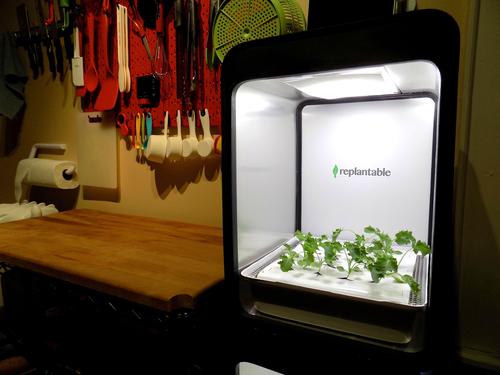Nanofarm Grows Fresh Veggies in Your Kitchen
September 1, 2016
By eliminating pumps, sensors, and actuators, a start-up has created a home appliance that autonomously grows food, and costs about half as much as its predecessors.
Known as the Nanofarm and designed by Replantable LLC, the new product enables users to grow lettuce, kale, oregano, thyme, basil, beets, radishes, and other produce that might ordinarily be bought at a grocery store. The difference is that the food is grown in a home unit about the size of a mini-fridge. "The benefit is you get to pick the food right before you eat it," Ruwan Subasinghe, co-founder of Replantable, told Design News. "Instead of using wilted lettuce that's been sitting in your fridge and took two weeks to get to the grocery store, you can pick it while it's alive and put it in your sandwich. And with our system, there are no pesticides."

The Nanofarm accomplishes all that with only a handful of parts -- an aluminum enclosure, tempered glass door, tray, grates, LED-based grow light, and the company's plant pads. Plant pads, ordered online, are placed in water and subjected to a bank of phosphor-coated LEDs that offer long wavelengths of light that can replace nature's sunlight.
"The goal is to make a natural daylight bulb, which is great for plants," Subasinghe said. He added that recent price drops in those LEDs enabled his company to take advantage of the technology. "The cost curve works great for us," he said. "And it will be an enabler of indoor agriculture in the future."
The product's other enabler is a plant pad that allows a tray of water to do the work of conventional soil. The plant pads release nutrients over a two- to six-week growth period, almost the way manure would in a garden.
By using capillary action, the pads enable Replantable to eliminate the sensors, water pumps, and actuators that are used in other hydroponic systems. Subasinghe said the company's product is targeted at a different market segment than other hydroponic systems. "We're aiming at people who like to cook and use fresh ingredients, but don't want to do traditional gardening," he told us.
The startup sells the Nanofarm for $350 -- about half the cost of similarly sized hydroponic systems targeted at gardeners. As the company scales up its manufacturing, that cost gap is likely to grow wider, Subasinghe said.
READ MORE ABOUT HOME APPLIANCE INNOVATIONS:
Replantable, launched by Georgia Tech grads, benefitted from guidance it received from the Georgia Center of Innovation for Energy Technology. Engineers at the Center provided access to a five-axis CNC mill to make the vacuum-formed molds for the Nanofarms's trays. "Tooling like that can cost thousands of dollars," Subasinghe said. "But partially through our affiliation, we were able to get the tooling made for a few hundred."
Ironically, the product's low cost may one day enable engineers to add one of the components that they originally eliminated. With help from the Georgia Electronic Design Center at Georgia Tech, Replantable might eventually add low-cost printable sensors to its product.
"Those printable sensors could be put in the water, and someone with an iPhone could monitor the amount of nutrients in the water," noted Costas Simoglou, who provided guidance via the Georgia Center of Innovation. "Or, users could measure, oxygen, CO, or CO2, and it could all be done from an app."
Ultimately, Subasinghe foresees the Nanofarm as a first step in a larger move toward indoor agriculture. "We see a potential for this to become cheap enough to be a viable alternative to buying produce at the grocery store," he said.
[images via Replantable LLC]
Senior technical editor Chuck Murray has been writing about technology for 32 years. He joined Design News in 1987, and has covered electronics, automation, fluid power, and autos.
About the Author(s)
You May Also Like



